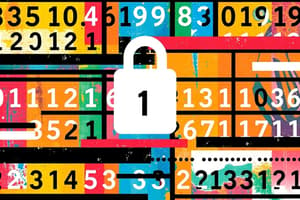Podcast
Questions and Answers
The Feistel network is primarily used to ensure that the algorithm is non-invertible.
The Feistel network is primarily used to ensure that the algorithm is non-invertible.
False (B)
Ciphertext is the original data/message that is input into the encryption algorithm.
Ciphertext is the original data/message that is input into the encryption algorithm.
False (B)
Symmetric cryptography uses different keys for encryption and decryption.
Symmetric cryptography uses different keys for encryption and decryption.
False (B)
The Advanced Encryption Standard (AES) utilizes the Rijndael algorithm to perform encryption.
The Advanced Encryption Standard (AES) utilizes the Rijndael algorithm to perform encryption.
Cryptanalysis is a method of protecting communication through the use of codes.
Cryptanalysis is a method of protecting communication through the use of codes.
Diffusion in cryptography spreads the influence of the plaintext and key bits over as much of the ciphertext as possible.
Diffusion in cryptography spreads the influence of the plaintext and key bits over as much of the ciphertext as possible.
The Data Encryption System (DES) encryption algorithm is capable of processing 128-bit key sizes.
The Data Encryption System (DES) encryption algorithm is capable of processing 128-bit key sizes.
Plaintext is the result of the encryption algorithm processing the original message.
Plaintext is the result of the encryption algorithm processing the original message.
The encryption process transforms messages into garbled data when intercepted by an untrusted user.
The encryption process transforms messages into garbled data when intercepted by an untrusted user.
A secret key is required for both encryption and decryption processes.
A secret key is required for both encryption and decryption processes.
A block cipher operates on data sizes of either 32 bits or 256 bits.
A block cipher operates on data sizes of either 32 bits or 256 bits.
Stream ciphers generate a sequence of pseudo-random bits, typically one bit at a time.
Stream ciphers generate a sequence of pseudo-random bits, typically one bit at a time.
Confusion in cryptography involves methods used to enhance the relationship between plaintext, ciphertext, and the key.
Confusion in cryptography involves methods used to enhance the relationship between plaintext, ciphertext, and the key.
The decryption algorithm can only process messages that were originally produced by a reverse cipher.
The decryption algorithm can only process messages that were originally produced by a reverse cipher.
Cryptology encompasses both cryptography and cryptanalysis.
Cryptology encompasses both cryptography and cryptanalysis.
Digital signatures are a crucial part of the authentication process in secure communications.
Digital signatures are a crucial part of the authentication process in secure communications.
In-transit encryption protects data stored on an information system.
In-transit encryption protects data stored on an information system.
At-rest encryption encrypts data before it is written to memory.
At-rest encryption encrypts data before it is written to memory.
The transposition cipher technique changes the order of characters to create the cipher.
The transposition cipher technique changes the order of characters to create the cipher.
Ciphertext-only attackers know the associated plaintexts of the ciphertexts they observe.
Ciphertext-only attackers know the associated plaintexts of the ciphertexts they observe.
Chosen-plaintext attackers can perform encryption queries for plaintexts of their choice.
Chosen-plaintext attackers can perform encryption queries for plaintexts of their choice.
The white box model gives attackers complete access to cryptographic algorithms.
The white box model gives attackers complete access to cryptographic algorithms.
Global deduction occurs when a cryptanalyst finds the key.
Global deduction occurs when a cryptanalyst finds the key.
The black-box model allows attackers to have insights based only on who wrote the code.
The black-box model allows attackers to have insights based only on who wrote the code.
Flashcards
Cryptography
Cryptography
The process of securing communication using codes and ciphers.
Cipher
Cipher
A method for encoding messages.
Encryption Algorithm
Encryption Algorithm
The set of instructions used to encrypt data.
Plaintext
Plaintext
Signup and view all the flashcards
Ciphertext
Ciphertext
Signup and view all the flashcards
Symmetric Cryptography
Symmetric Cryptography
Signup and view all the flashcards
Block Cipher
Block Cipher
Signup and view all the flashcards
Feistel Network
Feistel Network
Signup and view all the flashcards
In-transit encryption
In-transit encryption
Signup and view all the flashcards
At-rest encryption
At-rest encryption
Signup and view all the flashcards
Encryption in use
Encryption in use
Signup and view all the flashcards
Ciphertext-only attack (COA)
Ciphertext-only attack (COA)
Signup and view all the flashcards
Known-plaintext attack (KPA)
Known-plaintext attack (KPA)
Signup and view all the flashcards
Chosen-plaintext attack (CPA)
Chosen-plaintext attack (CPA)
Signup and view all the flashcards
Black-box model
Black-box model
Signup and view all the flashcards
Columnar transposition
Columnar transposition
Signup and view all the flashcards
Secret Key
Secret Key
Signup and view all the flashcards
Confusion
Confusion
Signup and view all the flashcards
Stream Cipher
Stream Cipher
Signup and view all the flashcards
Reverse cipher
Reverse cipher
Signup and view all the flashcards
Study Notes
Cipher Cryptography
- Cryptography is the process of secure communication using ciphers.
- Cryptanalysis is the process of deciphering secret communications.
- Cryptography uses algorithms to transform messages into unreadable formats.
- Cryptographic algorithms include key generation, digital signatures, and verifications.
- Cryptosystems regulate user behavior, like choosing strong passwords.
- Cryptographic algorithms encrypt and decrypt messages to protect computer systems.
Symmetric Cryptography
- Plaintext: Original data/message.
- Encryption Algorithm: Performs mathematical operations on plaintext to encrypt.
- Ciphertext: Scrambled message resulting from encryption.
- Secret Key: Input for encryption algorithm, used to decrypt.
- Decryption Algorithm: Uses ciphertext and key to generate the original message.
- Block Cipher: Operates on fixed-size blocks (e.g., 64 or 128 bits).
- Stream Cipher: Generates a stream of pseudo-random bits (one bit or byte at a time).
- Confusion: Techniques to hide the relationships between plaintext, ciphertext, and key.
- Diffusion: Spreading the influence of plaintext and key bits throughout the ciphertext.
- Feistel Network: Used in block ciphers to ensure invertibility.
- Data Encryption Standard (DES): Algorithm using fixed-length block ciphers with a secret key.
- Advanced Encryption Standard (AES): Uses the Rijndail algorithm, often with 256-bit keys.
Encryption and Decryption Processes
- Procedure: Steps in the encryption and decryption process.
- Techniques: Methods used for encryption and decryption.
- Algorithms: Specific sets of mathematical calculations used in encryption.
- Cryptology: The study of cryptography and cryptanalysis.
Brute Force Technique
- Attack Models: Sets of assumptions about attacker interactions with ciphers.
- Black-box Model: Attacker has limited access to the cipher's implementation.
- Gray-box Model: Attacker has some understanding of the cipher's implementation.
- White-box Model: Attacker has full knowledge of the cipher's implementation.
- Ciphertext-only Attack (COA): Attacker observes ciphertext only.
- Known-plaintext Attack (KPA): Attacker observes both ciphertext and plaintext.
- Chosen-plaintext Attack (CPA): Attacker can choose plaintexts and observe the corresponding ciphertexts.
- Brute-force Attack: Trying every possible decryption key.
- In-transit Encryption: Protects data in transit between systems.
- At-rest Encryption: Protects data stored on a system.
- Encryption in use: Protects data in memory.
- Categories of Breaking an Algorithm (Lars Knudsen): Total break (finding the key), global deduction (alternate algorithm), instance deduction (plaintext), information deduction (key or plaintext info).
- Unconditional Security (Strong): Cannot be broken even with unlimited resources.
Transposition Cipher
- Transposition Cipher Technique: Rearranges characters in the plaintext to create ciphertext without changing the letters themselves.
- Columnar Transposition: A specific form arranging plaintext in a matrix and then reordering columns.
Studying That Suits You
Use AI to generate personalized quizzes and flashcards to suit your learning preferences.





